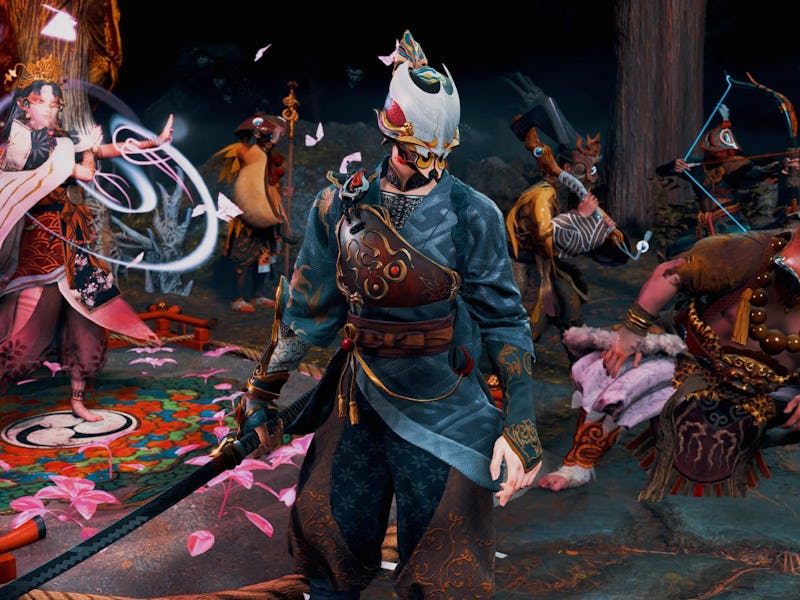
Kunitsu-Gami: Path of the Goddess feels like a game that came out twenty years ago during the height of the PlayStation 2, in the best way possible. It’s wholly unlike anything else out there, and a risky swing from a major publisher to establish a new world, and one that iterates on a fairly niche genre at that. Kunitsu-Gami’s fusion of tower defense and action RPG is fascinating, but it’s also steeped in a unique aesthetic, culture, and mythology.
“The start of this title was inspired by the Japanese "Kagura," [a type of Shinto ritual ceremonial dance]. We hope that people who are not from Japan will become interested in the Japanese culture and elements in some way,” Kunitsu-Gami director Shuichi Kawata tells Inverse, “Our team's goal is to make the players experience this and have them look at things from a new perspective.”
Everything in Kunitsu-Gami is themed around Japanese Kagura, from Soh’s movements and combat to the entire aesthetic of the game.
That strong basis in Japanese culture is part of what makes Kunitsu-Gami so striking, as the development team leaned hard into the style and aesthetic of Kagura. The visual style is done in gorgeous watercolor, with every element of the game’s menu and user interface meant to feel immersive, like your equipment menu being made up of scrolls, talismans, and strands of rope.
But it goes much deeper than just visual representation, the game’s inspirations are also layered into gameplay and mechanics. To match the theme of ritualistic dancing, Kunitsu-gami is almost entirely devoid of voiced dialogue, instead communicating its story and character’s personalities through exaggerated movements.
On top of this the combat style of the main character, Soh, is meant to look like a dance, with flowing movements that leave lingering trails of energy. Soh’s two different combat styles are even themed around two types of movements in Japanese dance, “mai” and “odori.” Mai is typically about slower movements, like a mellow shuffle, matching Soh’s second style, while Odori leans more heavily on showy and boisterous movements, like Soh’s initial style.
Those are just a few examples of how Kunitsu-Gami stays dedicated to its core vision, but the fact it manages to do just that is what’s so impressive. 2024 has been a rough year for the video game industry, with thousands of layoffs and multiple studios closed. There’s a clear trend where studios and publishers are becoming more averse to taking risks, instead banking on popular trends like hero shooters, or big sequels from established franchises.
Kunitsu-Gami isn’t just a one-off, as last year’s Exoprimal was a similarly ambitious new experience that blended multiple genres together.
Games like Kunitsu-Gami, and last year’s Exoprimal, fly in the face of all that. Capcom has its established franchises, like Resident Evil and Monster Hunter, that are doing gangbusters, but the company is also willing to take chances on smaller imaginative projects. A big part of that is cross-communication.
“I have regular meetings with the team. In the meeting, I share with them what is going on with other teams and anything that I think can be helpful or used as a reference,” Kunitsu-Gami producer Yoshiaki Hirabayashi tells Inverse.
In this way, teams at Capcom can collaborate and learn from each other, but according to Kawata, it’s equally important to cultivate talent and make sure that a project is a learning opportunity. Kawata previously worked on Shinsekai: Into the Depths, another Capcom new IP that launched on Apple Arcade in 2019. Coming off of that game, Kawata deliberately wanted to do something different from other projects at Capcom.
“I believe that the experience with a series or remake is important, but the experience of a new IP is also important,” Kawata says, “Since this was a unique opportunity, I thought that by challenging myself to create a new IP with the entire team under limitations, I would be able to form my ideas into shape, create things and turn them into products, and gain experience as a team, which would lead to the growth of the team and for each individual.”
Capcom is continuing to invest in both new experiences and remakes, with September’s Dead Rising Deluxe Remaster.
It’s hard to not feel like Capcom is doing something right in an industry filled with poor decisions. While others are letting employees go left and right, Capcom hasn’t been hit with any layoffs, instead increasing all employee’s salaries by roughly five percent in March 2024. Alongside that announcement, the company said “Capcom is pursuing further investment in human capital and the acquisition of exceptional talent.”
The results should speak for themselves. Good video games are made by passionate developers with the time and resources to create, and the outcome of that is games like Kunitsu-Gami.
In an interview last September, Alan Wake 2 creative director Sam Lake told Inverse he wants video games to “be bold enough to keep experimenting.” Kunitsu-Gami feels like the exact kind of game Lake was talking about, a game that takes chances and wholeheartedly commits to its singular vision. It’s undoubtedly what we need more of.